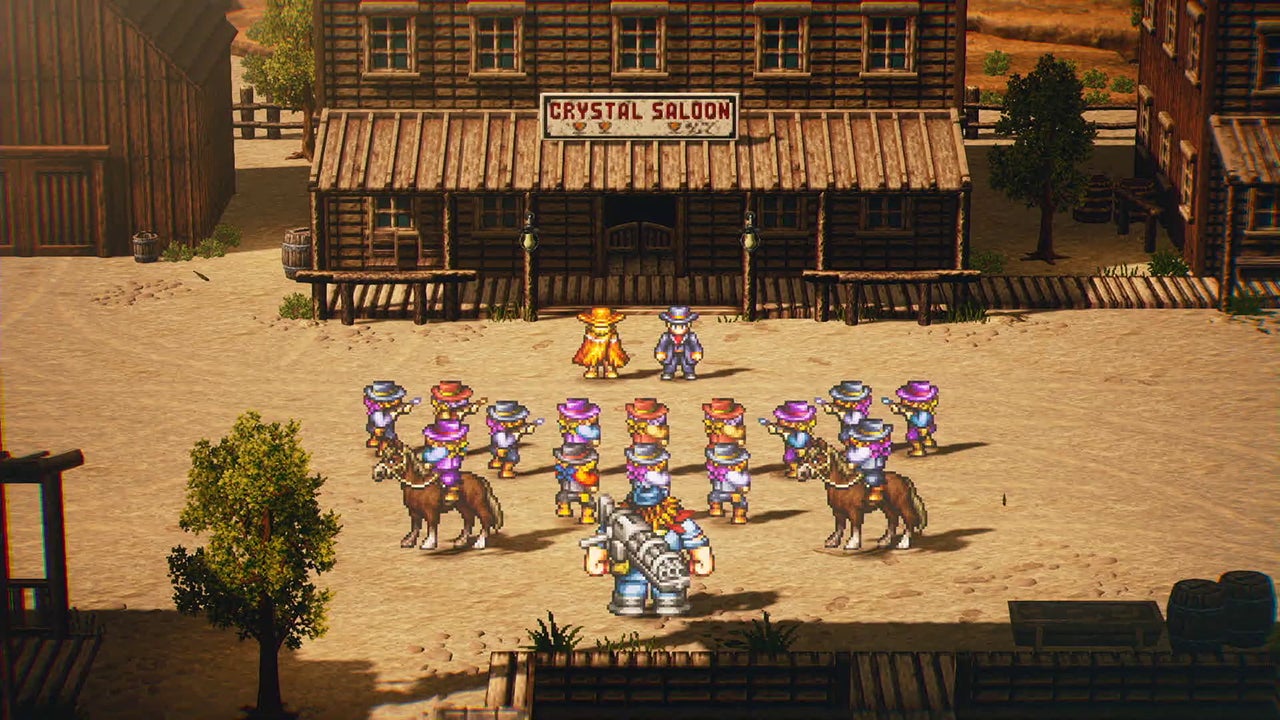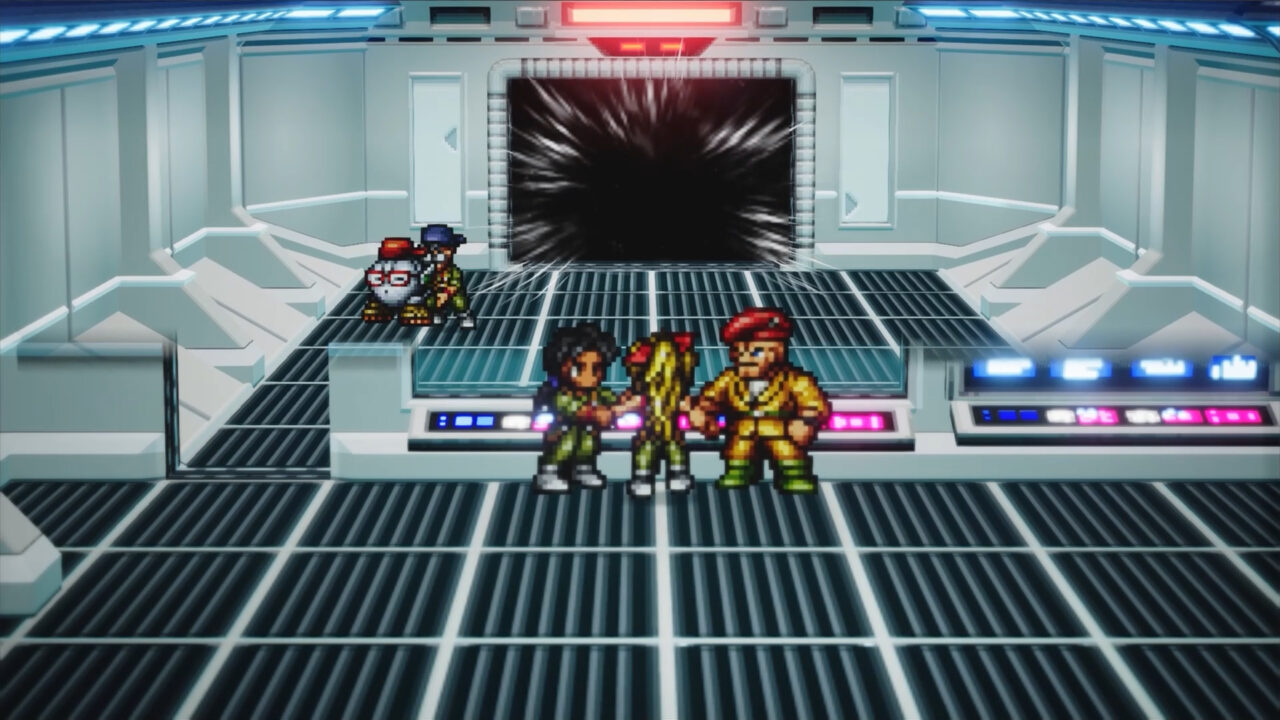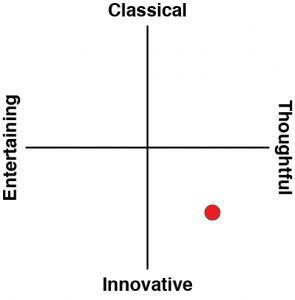In most cases, I play JRPGs for the narrative. I want to be lost in the characters, setting, plot and world. I like when it’s supported by quality gameplay mechanics, of course, but the frameworks and structures that support that narrative are less of a focus for me than that narrative. Live A Live is a very beast different that I found fascinating to play for very different reasons and, supported by a gorgeous modern aesthetic, still feels like one of the most creative and experimental games that Square Enix has ever produced, nearly 30 years after it was first launched on the SNES.
Live A Live’s most interesting quality is that it tracks the stories of multiple characters – eight in all, and they take place in vastly different time periods, from ancient pre-history through to the distant future. That in itself is not that unique, but each of Live A Live’s scenarios has been carefully built so that the way they play is entirely unique – and appropriate – to that time period and scenario and that is less common. Usually when games to multiple time periods, or different settings, they maintain the same basic gameplay. Here, though, it’s not just that each scenario looks different. It operates to an entirely different set of rules. So for example, in the scenario set in Sengoku Japan, you play as a ninja that has the unique ability to hide from enemies, and are encouraged to do so as your hero is keeping an ominous countdown of the lives that he’s taken.
Meanwhile, the boxer’s chapter, set in the modern era, tells the story of a guy that’s determined to be the world’s best fighter, and that scenario allows you to choose your opponents from a Street Fighter-like character select screen. Some scenarios feature random encounters, some are scripted, and some basically forego combat entirely. The combat – when it occurs – plays out in the same way in each scenario (turn-based on a gird), but the special abilities that your character has access to, and the way that those battles are fought therefore have a very different texture.
So, for the longest time, Live A Live doesn’t feel like a single cohesive narrative, or even game, but rather a collection of individual vignettes, novellas, or short stories (whatever you want to call them) that might be linked in a general sense, but play as differently as the stories within them are different. There is an eventual chapter that ties things together (and it’s a good one), but by then you’ve been well and truly drawn into the eclectic energy of this thing. Each individual chapter is relatively short, and this, too, is a strength, in that Live A Live never allows itself to get trapped into a grind, and people can step into it knowing that they’ll get a fair chunk of the way through a complete narrative arc in their session. Individually, the stories being told aren’t masterpieces, but the patchwork tapestry quality makes the overall experience memorable and distinct.
The decision to remake the game using the “HD-2D” technique found in Octopath Traveler and Triangle Strategy was an inspired one. Thanks to the HD-2D, the sprites look highly modern, while at the same time preserving the “SNES” quality of the game. When you’ve got such a gorgeous range of settings to explore, there are some inherent advantages to sprite work over 3D art – the “gallery” quality of having different location and time period settings becomes far more apparent. The wild west setting looks like a completely different chapter to the futuristic setting, for example.
It’s also worth noting that each of the scenarios had different art designers – this was a major selling point of the game on its original release, and the HD-2D approach is a superior way of preserving their work in that context too.
If there’s one downside to the game it’s that the vignette approach does mean that you don’t get to become deeply invested in any character like you would from a more sustained approach. This can leave Live A Live coming across as a little dry and academic, and your ability to change between narratives at will doesn’t change that impression (though it is good that you can give yourself a break from the rare moment that Live A Live might be a little too challenging to you). People looking for an emotional connection to any of the characters probably won’t find it. It’s going to make for an interesting contrast with Nintendo’s release schedule, as Xenoblade Chronicles 3 – a JRPG that is very much focused on building a deep emotional connection between players and their characters – is just around the corner itself.
I realise this is a pretty short review by my standards for the JRPG genre, but there really isn’t much else to say about Live A Live; this is a quirky and fundamentally experimental JRPG that in many ways remains out there on its own. The chapter-based approach to simple (but enjoyable) narratives that take place across time and space allows for an experience that is both varied and flexible. Throw in the most excellent application of HD-2D art for the remake, and the fact that this is the first time this game has had a formal release in the west, and Live A Live is an essential experimental title for the curious and those that enjoy playing things that are genuinely different.












I can never follow the story in jrpg’s. There’s basically always a part where I have to grind for so long, by the time I get back to the story I’ve forgotten what it was all about.
This one doesn’t have much by way of grindy segments, and because of its structure, the narratives are more streamlined and efficient, so it might be a good one for you to try.
Sounds good. And it’s only not that long which I consider a huge plus.
If there’s one downside to the game it’s that the vignette approach does mean that you don’t get to become deeply invested in any character like you would from a more sustained approach. This can leave Live A Live coming across as a little dry and academic
Is this game literally perfect or does it have downsides? What’s the point of reviewing games if you’re going to give a less-than-perfect game a perfect score?
From our scoring policy (https://www.digitallydownloaded.net/scoring-and-comments-policy):
“A game that receives a score of 5 stars is something we can recommend to all gamers. These types of games are, in the eyes of the person that reviewed the game, important in some way to the games industry. It could be that we give a 5-star game to something that isn’t necessarily entertaining to play, provided it has a strong, compelling message.
Please don’t argue with us that we’re calling a game “perfect” if we give it 5 stars. It’s not, any more than a 5-star hotel or restaurant is the best thing you’ll ever experience in your life.”
Also, if you’re going to take snippy little swings at me, perhaps you should make sure you know how to use basic words like “literally” correctly, first. There are far more civil and intelligent ways you could have asked that question, but instead, you decided to act like a gamer.
Have a nice day, champ.